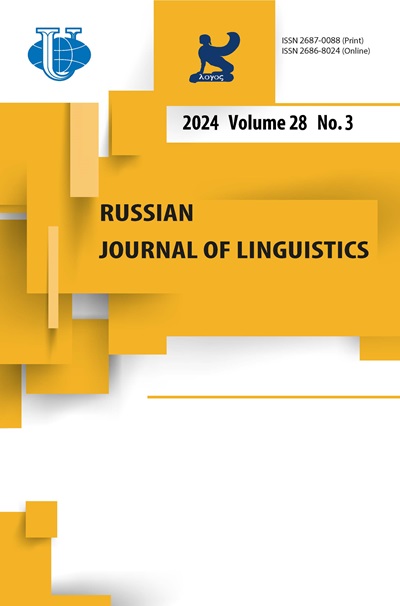ВЫРАЖЕНИЕ ЧУВСТВ И ЭМОЦИЙ В ПРОПОЗИЦИИ: ВЗГЛЯД НА ИРОНИЮ И ИНТЕРНЕТ-КОММУНИКАЦИЮ
- Авторы: Юс Ф.1
-
Учреждения:
- Университет Аликанте
- Выпуск: Том 22, № 1 (2018): Дискурс эмоций
- Страницы: 94-107
- Раздел: Статьи
- URL: https://journals.rudn.ru/linguistics/article/view/17849
- DOI: https://doi.org/10.22363/2312-9182-2018-22-1-94-107
Цитировать
Полный текст
Аннотация
Чувства и эмоции, обычно не связанные с пропозицией, играют большую роль в процессе интерпретации того, к чему они относятся. Тем не менее, теория релевантности предпочтительно акцентирует внимание на том, как слушающие строят предположения, заполняющие разрыв между тем, что имелось в виду, и что было понято (Carston 2002). Эти предположения обладают ментальной репрезентацией и являются объектом изучения лингвистов (Chapman 2001, García-Carpintero 2010, Moeschler 2009). Статья представляет собой обзор некоторых способов выражения чувств и эмоций, которые играют важную роль в интерпретации сказанного. Автор уделяет особенное внимание иронии (Yus 2016a, 2016b) и интернет-коммуникации (Yus 2016c, в печати).
Ключевые слова
Об авторах
Франсиско Юс
Университет Аликанте
Email: francisco.yus@ua.es
ФРАНСИСКО ЮС преподает прагматику в университете Аликанте на кафедре английского языка. Защитил диссертацию по лингвистке. Сфера научных интересов: прагматика, дискурсанализ, медиа-дискурс, прикладная лингвистика, социолингвистика, интернет-коммуникация, вежливость, ирония и юмор. Carretera San Vicente del Raspeig, s/n, 03690 San Vicente del Raspeig, Alicante, Испания
Список литературы
- Akimoto, Y., Sugiura, M., Yomogida, Y., Miyauchi, C.M., Miyazawa, S. & Kawashima, R. (2014). Irony comprehension: Social conceptual knowledge and emotional response. Human Brain Mapping, 35, 1167-1178. doi: 10.1002/hbm.22242.
- Caffi, C. & Janney, R.W. (1994). Toward a pragmatics of emotive communication. Journal of Pragmatics 22, 325-373. doi: 10.1016/0378-2166(94)90115-5.
- Carston, R. (2002). Thoughts and Utterances. Oxford: Blackwell.
- Carston, R. (2009). Explicit/implicit distinction. In Cummings, L. (ed.), The Pragmatics Encyclopedia. London: Routledge, 154-162.
- Chapman, S. (2001). In defence of a code: Linguistic meaning and propositionality in verbal communication. Journal of Pragmatics 33, 1553-1570. doi: 10.1016/S0378-2166(01)00009-1.
- García-Carpintero, M. (2010). Linguistic meaning and propositional content. In Romero, E. & B. Soria (eds.), Explicit Communication: Robyn Carston’s Pragmatics. Basingstoke: Palgrave Macmillan, 75-91.
- Gibbs, R.W., Leggitt, J.S. & Turner, E.A. (2002). What’s special about figurative language in emotional communication? In Fussell, S.R. (ed.), The Verbal Communication of Emotions. Interdisciplinary Perspectives. Mahwah: L.E.A., 125-149.
- Kidron, Y. & Kuzar, R. (2002). My face is paling against my will. Emotion and control in English and Hebrew. Pragmatics & Cognition, 10 (1/2), 129-157. doi: 10.1075/pc.10.12.07kid.
- Langlotz, A. & Locher, M.A. (2013). The role of emotions in relational work. Journal of Pragmatics, 58: 87-107. doi: 10.1016/j.pragma.2013.05.014.
- Moeschler, J. (2009). Pragmatics, propositional and non-propositional effects: Can a theory of utterance interpretation account for emotions in verbal communication? Social Science Information, 48 (3), 447-464. doi: 10.1177/0539018409106200.
- Sperber, D. & Wilson, D. (1995). Relevance. Communication and Cognition (2nd ed.). Oxford: Blackwell.
- Sperber, D. & Wilson, D. (2015). Beyond speaker’s meaning. Croatian Journal of Philosophy, XV (44), 117-149.
- Schwarz-Friesel, M. (2015). Language and emotion. The cognitive linguistic perspective. In Lüdtke, U.M. (ed.), Emotion in Language. Theory - Research - Application. Amsterdam: John Benjamins, 157-173.
- Strey, C. (2016). The Language of Emotions: An Ostensive-Inferential Study. Ph.D Thesis. Porto Alegre: Pontifical Catholic University of Rio Grande do Sul.
- Thompson, C. (2008). Brave new world of digital intimacy. The New York Times, September 5th, Magazine.
- van Kleef, G.A. (2016). The Interpersonal Dynamics of Emotion. Toward an Integrative Theory of Emotions as Social Information. Cambridge: Cambridge University Press.
- Wharton, T. (2016). That bloody so-and-so has retired: Expressives revisited. Lingua, 175-176, 20-35. doi: 10.1016/j.lingua.2015.08.004.
- Wilson, D. & Wharton, T. (2006). Relevance and prosody. Journal of Pragmatics, 38(10), 1559- 1579. doi: 10.1016/j.pragma.2005.04.012.
- Yus, F. (2007). Virtualidades Reales. Nuevas Formas de Comunidad en la Era de Internet. Alicante: University of Alicante, Servicio de Publicaciones.
- Yus, F. (2011). Relevance equations of effective Internet communication. In Pennock, B. & Suau, F. (eds), Interdisciplinarity and languages. Current issues in Research, Teaching, Professional Applications and ICT. Frankfurt: Peter Lang, 65-86.
- Yus, F. (2014). Turismo móvil: Discurso, interactividad y usabilidad en las ‘apps’ de turismo”. Paper delivered at Discurso y Géneros del Turismo 2.0. University of Valencia and IULMA, Valencia, April.
- Yus, F. (2015a). Should relevance theory analyse what is non-propositional, non-intentional but yet affects the eventual relevance? Paper delivered at Relevance Round Table Meeting 4. Kraków: Institute of English Studies, Jagiellonian University of Kraków, September.
- Yus, F. (2015b). The discursive management of the phatic Internet (and how to explain it pragmatically). Paper delivered at Approaches to Digital Discourse Analysis (ADDA). Valencia (Spain), November.
- Yus, F. (2015c). Broadening the (propositional) scope of pragmatics in order to address the (nonpropositional) quality of humorous effects. Paper delivered at I Workshop on Advanced Studies of Humor and Gender (WASHUM). Alicante (Spain): University of Alicante, November.
- Yus, F. (2015d). The role of cognition and relevance in new digital narratives. In: Carpi, E. (ed.), Prospettive Multilingue e Interdisciplinari nel Discorso Specialistico. Pisa: Pisa University Press, 81-107.
- Yus, F. (2016a). Propositional attitude, affective attitude and irony comprehension. Pragmatics & Cognition, 23(1), 92-116. doi: 10.1075/pc.23.1.05yus.
- Yus, F. (2016b). Humour and Relevance. Amsterdam/Philadelphia: John Benjamins.
- Yus, F. (2016c). The phatic Internet. Networked feelings and emotions across the propositional-nonpropositional and the intentional-unintentional board. Paper delivered at the International Conference on Language and Emotion. Madrid, November.
- Yus, F, (2016d). Towards a cyberpragmatics of mobile instant messaging. In: Romero-Trillo, J. (ed.), Yearbook of Corpus Linguistics and Pragmatics 2016: Global Implications for Culture and Society in the Networked Age. Berlin: Springer, 7-26.
- Yus, F. (2016e). La seducción de lo no codificado. In Beguelin, V. & Cordone, G. (eds.), Manifestaciones intermediales de la literatura hispánica del siglo XXI. Madrid: Visor, 33-53.
- Yus, F. (2017). Contextual constraints and non-propositional effects in WhatsApp communication. Journal of Pragmatics, 114, 66-86. doi: 10.1016/j.pragma.2017.04.003.
- Yus, F. (forthcoming) Relevance from and beyond propositions. The case of online identity. In Nasu, H. & Strassheim, J. (eds.), Relevance and Irrelevance: Theories, Fa.

















